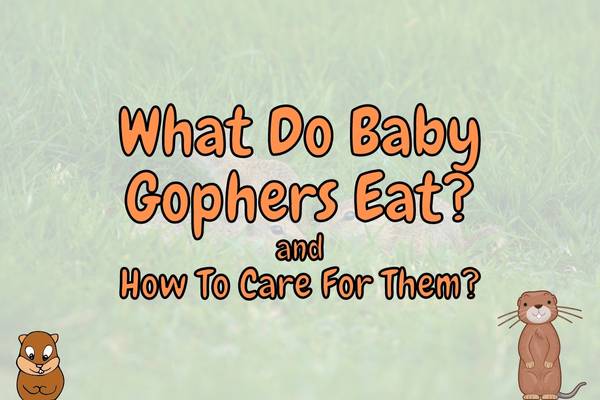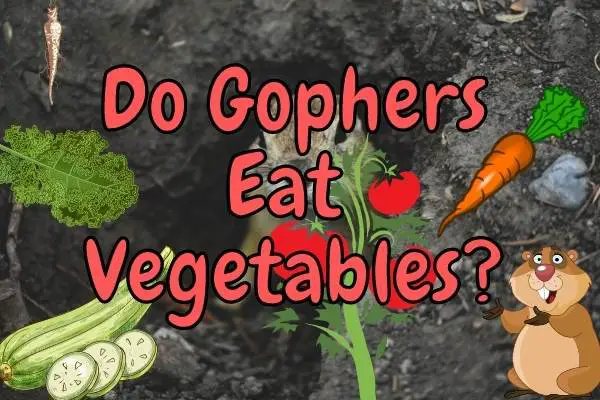Gophers are small, burrowing rodents found in North and Central America. They are well-known for their love of digging and their intricate tunnel systems. Adult gophers are primarily herbivores, and their diet consists mostly of plants, seeds, and fruits.
Baby gophers, like other mammals, drink milk from their mother in the first few weeks of life. Later they start to eat a diet of small worms, insects, roots, and vegetables as the adults do. If you find a baby gopher, this post will guide you to take proper care of it!
There are several different species of gopher, including the different pocket gophers. Gophers are generally shy creatures, but they can be aggressive if they feel threatened.
Gophers can be a nuisance to homeowners and farmers because of their digging habits. They often damage crops and gardens by burrowing through them.

So if you have a gopher problem, there are several things you can do to get rid of them. But in this post, we will tackle a slightly different question: How do you take care of a baby gopher?
What do newborn gophers eat?
As newborn gophers are born, they will drink milk from their mother. If you have a baby gopher that needs to be bottle-fed, you can give them goat’s milk, cow’s milk, or a special formula designed for rodents.
Later, it is important to make sure that they always have access to water, and you can provide this by filling a shallow dish and placing it in their enclosure.
They should also have fresh vegetables and fruits as part of their diet. Once they get a bit older, you can switch to pellets made specifically for gophers.
If you’re considering keeping a baby gopher as a pet, please read on so that you can provide them with the best possible care.
What to feed a baby gopher?
A baby gopher’s diet consists of milk, water, and fresh fruits and vegetables. If you are bottle-feeding a baby gopher, you can give them goat’s milk, cow’s milk, or a special formula designed for rodents.
It’s important to make sure that they always have access to water, and you can provide this by filling a shallow dish and placing it in their enclosure.
They should also have fresh vegetables and fruits as part of their diet. Once they get a bit older, you can switch to pellets made specifically for gophers.
If you’re considering keeping a baby gopher as a pet, please do your research first so that you can provide them with the best possible care.
Older gophers consume a wide variety of vegetation with no particular preference. Crops, flowers, and plants have been damaged by them. Gopher’s diets are affected by the availability of food sources.
I have already written about the diet of gophers, so you can read more in my recent posts:
They consume plants that are part of the yearly flora-eating cycle. Depending on the season, a gopher’s diet may change. Foods eaten by gophers include a broad range of things, but these are the most common:
- Tree roots and barks
- Flowering plants
- Seeds
- Grasses
- Sweet potatoes
- Bulbs
- Fleshy roots of trees and plants
- Succulent vegetation
- Pet foods
- Some meat, insects and worms
- Some human foods
- Dandelions and alfalfa
- Numerous other garden vegetables.
If you are more interested in the diet of gophers, check out my other posts on that subject here on the site!
Do gophers drink water?
Yes! Gophers need to drink water if their diet is not high in fruits and watery vegetables like cucumbers, tomatoes, and large roots.
Baby gophers do not need water while drinking their mother’s milk, but soon after they will need other sources of liquid.
They may also get their water from snow which they chew and eventually drink.
They will even jump into the water and swim occasionally!
How do gophers get water?
Gophers get water from a variety of sources, including rain, snow, dew, and underground streams.
They also consume a lot of plants, which contain moisture.
They may also sneak up to a lake or stream to drink water, or simply drink the rainwater that drips into their tunnels! If you wonder how they avoid drowning when it rains, I did write about how gophers keep their ability to breathe underground.
Pet gophers get water from drinking dishes that are placed in their enclosure or from eating fresh fruits and vegetables.
Gophers generally drink water when they are eating plants, but they will also drink from puddles or other bodies of water when they are available.
What to do with a baby gopher?
If you are considering keeping a baby gopher as a pet, please do your research to ensure that you can provide them with the proper care and diet they need.
A baby gopher should be kept in a warm and dry place. It is important to keep the baby gopher away from any potential predators, such as cats or dogs. The baby gopher should also have access to fresh water and food.
Gophers need to drink water, and you can provide this by filling a shallow dish and placing it in their enclosure.
They should also have fresh vegetables and fruits as part of their diet. Once they are older, they can eat pellets designed specifically for gophers, which makes things easier for them and you!

However, newborn baby gophers need to drink milk in their first couple of weeks in order to survive.
You can use a syringe or bottle to feed them milk. It is important to make sure that the milk is not too hot or cold, as this can harm the gopher. Once they are old enough, you can start giving them water and solid foods.
Gophers typically get their water from the plants they eat, but you can also give them a bowl of water to drink from.
Just make sure to change it regularly so that it stays clean. Baby gophers are also known to eat insects, so you can offer them small bugs as a treat.
However, their main diet should still be milk. If you take care of a baby gopher properly, it can eventually become a pet. So it is important to be patient and give them the time they need to grow.
Can you keep a baby gopher as a pet?
Yes, you can keep a baby gopher as a pet, but it’s important to do your research first so that you can provide them with the best possible care.
Most people who adopt a baby gopher will do it with the intention of setting it free later, which you will have to keep in mind when you raise it!
If you find a baby gopher, it is important to take care of it properly so that it can grow up healthy and strong. Here are some tips on how to take care of a baby gopher:
1. The first thing you need to do is find a suitable home for the gopher. Initially, it should be a nest box with lots of soft material like fine hay to keep it warm.
This should later be replaced with a large enclosure with plenty of space for the gopher to move around and explore. The enclosure should also have some hiding places for the gopher to feel safe and secure.
2. Once you have found a suitable home for the young gopher, you will need to set up some basic necessities. This includes food, water, bedding, and litter. It is important to use pet-safe products for all of these items so that the gopher is not exposed to any harmful chemicals or toxins.
3. Next, it is important to provide regular care for the gopher as it grows up. This includes cleaning out its enclosure regularly, providing fresh food and water daily, and taking it to the vet for regular check-ups
4. Finally, if you intend to keep the gopher (which I would generally not recommend!) you will need to socialize the gopher so that it can become used to being around humans.
This can be done by slowly introducing the gopher to your presence and offering it treats occasionally.
With time and patience, the gopher should become more comfortable with humans and may even start approaching them on its own accord!
However, it is very important that you only do this if you intend never to set it free as it will otherwise have a hard time surviving on its own!
Although baby gophers can be kept easily indoors, adults are wild animals that do require a lot of space. You will also need to let them out to roam around and explore occasionally.
Baby gophers make good pets if you take care of them properly, but you need to be intentional about it.
They should also have fresh vegetables and fruits as part of their diet. Once they get a bit older, you can switch to roots and plants that adult gophers like.
Conclusion
Baby gophers are easy to take care of if you know what their diet consists of and what their needs are. They should have milk, water, fresh fruits and vegetables, and access to a clean enclosure. Once they get a bit older, you can switch them to pellets made specifically for gophers.
Gophers obtain water from plants, moisture in the soil, rain, and snow, one of which should also be available to them and they will even swim if you let them!
Gophers can also carry diseases that can be harmful to humans and other animals which may transmit via their sharp teeth and claws that they use to defend themselves. So be careful when picking them up!






